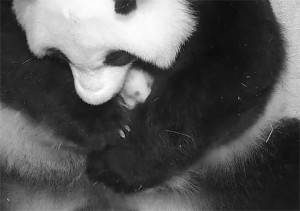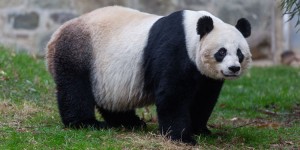Baby Panda Born!
Thursday, September 17th, 2020
The giant panda Mei Xiang snuggles her newborn cub, born at the Smithsonian’s National Zoological Park on Aug. 21, 2020.
Credit: Smithsonian National Zoo & Conservation Biology Institute
This summer, a giant panda named Mei Xiang gave birth at Smithsonian’s National Zoo in Washington, D.C. At 22 years of age, she is the oldest giant panda in the United States to give birth.
The female giant panda gives birth every two or three years to one or two cubs. Panda cubs are extremely tiny, weighing only about 5 ounces (140 grams) at birth. In fact, panda cubs are about the size of a stick of butter! The mother, who normally spends about 12 hours a day eating, stays with the newborn cub for up to 10 days without feeding. Cubs normally nurse for about a year and may remain with the mother for more than two years.
The new cub has siblings. Mei Xiang has given birth to three surviving cubs. Tai Shan was born in 2005. Bao Bao was born in 2013. And, Bei Bei was born in 2015. All three pandas live in China.

The giant panda Mei Xiang at the Smithsonian’s National Zoological Park in Washington, D.C.
Credit: Smithsonian National Zoo & Conservation Biology Institute
Pandas are in danger of dying out completely. Widespread cutting of forests for wood and farmland in China has destroyed a large part of the habitat of giant pandas. China’s government has tried to protect these pandas by establishing reserves of bamboo-rich public land for them. They are protected by national and international laws.
Other efforts to ensure the survival of giant pandas have focused on breeding them in zoos, as happened with Mei Xiang. Giant pandas initially proved extremely difficult to breed in captivity. After years of failed attempts, scientists have made great progress in breeding the animals. Zoos now hold more than 300 giant pandas. This number is considered the minimum needed to preserve the animal. Scientists are researching methods for introducing pandas that were born in captivity into the wild.
Many people considered the birth a miracle, due to Mei Xiang’s advanced age. The birth also presented a much-needed cause for celebration during the ongoing pandemic (global outbreak) of the coronavirus disease COVID-19.



